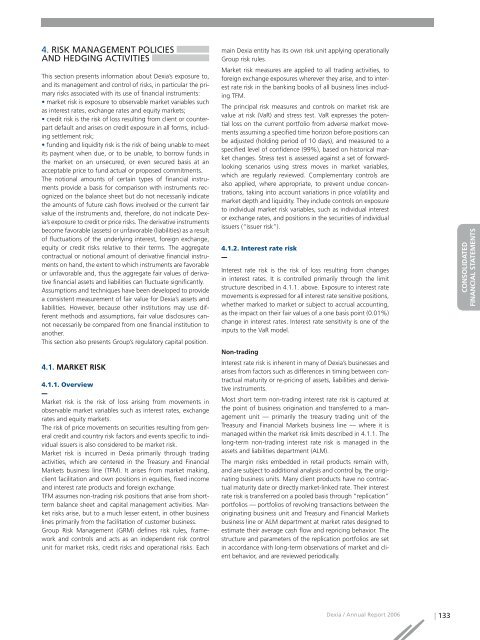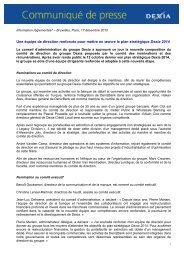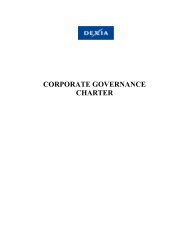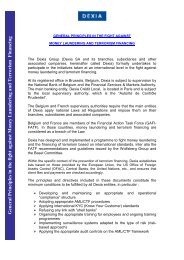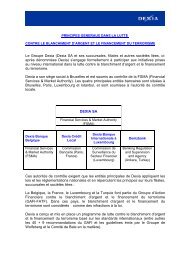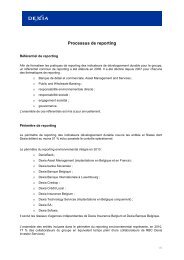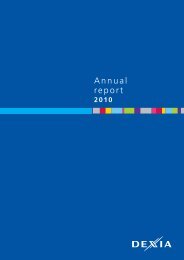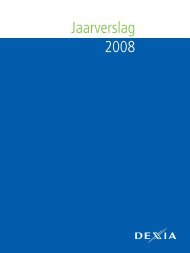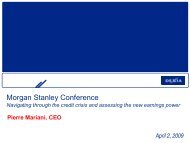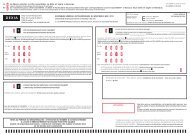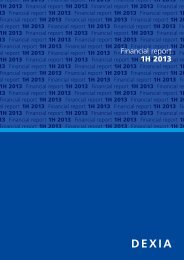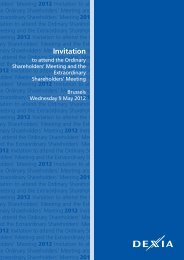Annual report 2006 - Dexia.com
Annual report 2006 - Dexia.com
Annual report 2006 - Dexia.com
You also want an ePaper? Increase the reach of your titles
YUMPU automatically turns print PDFs into web optimized ePapers that Google loves.
4. RISK MANAGEMENT POLICIES<br />
AND HEDGING ACTIVITIES<br />
This section presents information about <strong>Dexia</strong>’s exposure to,<br />
and its management and control of risks, in particular the primary<br />
risks associated with its use of financial instruments:<br />
• market risk is exposure to observable market variables such<br />
as interest rates, exchange rates and equity markets;<br />
• credit risk is the risk of loss resulting from client or counterpart<br />
default and arises on credit exposure in all forms, including<br />
settlement risk;<br />
• funding and liquidity risk is the risk of being unable to meet<br />
its payment when due, or to be unable, to borrow funds in<br />
the market on an unsecured, or even secured basis at an<br />
acceptable price to fund actual or proposed <strong>com</strong>mitments.<br />
The notional amounts of certain types of financial instruments<br />
provide a basis for <strong>com</strong>parison with instruments recognized<br />
on the balance sheet but do not necessarily indicate<br />
the amounts of future cash flows involved or the current fair<br />
value of the instruments and, therefore, do not indicate <strong>Dexia</strong>’s<br />
exposure to credit or price risks. The derivative instruments<br />
be<strong>com</strong>e favorable (assets) or unfavorable (liabilities) as a result<br />
of fluctuations of the underlying interest, foreign exchange,<br />
equity or credit risks relative to their terms. The aggregate<br />
contractual or notional amount of derivative financial instruments<br />
on hand, the extent to which instruments are favorable<br />
or unfavorable and, thus the aggregate fair values of derivative<br />
financial assets and liabilities can fluctuate significantly.<br />
Assumptions and techniques have been developed to provide<br />
a consistent measurement of fair value for <strong>Dexia</strong>’s assets and<br />
liabilities. However, because other institutions may use different<br />
methods and assumptions, fair value disclosures cannot<br />
necessarily be <strong>com</strong>pared from one financial institution to<br />
another.<br />
This section also presents Group’s regulatory capital position.<br />
4.1. MARKET RISK<br />
4.1.1. Overview<br />
Market risk is the risk of loss arising from movements in<br />
observable market variables such as interest rates, exchange<br />
rates and equity markets.<br />
The risk of price movements on securities resulting from general<br />
credit and country risk factors and events specific to individual<br />
issuers is also considered to be market risk.<br />
Market risk is incurred in <strong>Dexia</strong> primarily through trading<br />
activities, which are centered in the Treasury and Financial<br />
Markets business line (TFM). It arises from market making,<br />
client facilitation and own positions in equities, fixed in<strong>com</strong>e<br />
and interest rate products and foreign exchange.<br />
TFM assumes non-trading risk positions that arise from shortterm<br />
balance sheet and capital management activities. Market<br />
risks arise, but to a much lesser extent, in other business<br />
lines primarily from the facilitation of customer business.<br />
Group Risk Management (GRM) defines risk rules, framework<br />
and controls and acts as an independent risk control<br />
unit for market risks, credit risks and operational risks. Each<br />
main <strong>Dexia</strong> entity has its own risk unit applying operationally<br />
Group risk rules.<br />
Market risk measures are applied to all trading activities, to<br />
foreign exchange exposures wherever they arise, and to interest<br />
rate risk in the banking books of all business lines including<br />
TFM.<br />
The principal risk measures and controls on market risk are<br />
value at risk (VaR) and stress test. VaR expresses the potential<br />
loss on the current portfolio from adverse market movements<br />
assuming a specified time horizon before positions can<br />
be adjusted (holding period of 10 days), and measured to a<br />
specified level of confidence (99%), based on historical market<br />
changes. Stress test is assessed against a set of forwardlooking<br />
scenarios using stress moves in market variables,<br />
which are regularly reviewed. Complementary controls are<br />
also applied, where appropriate, to prevent undue concentrations,<br />
taking into account variations in price volatility and<br />
market depth and liquidity. They include controls on exposure<br />
to individual market risk variables, such as individual interest<br />
or exchange rates, and positions in the securities of individual<br />
issuers (“issuer risk”).<br />
4.1.2. Interest rate risk<br />
Interest rate risk is the risk of loss resulting from changes<br />
in interest rates. It is controlled primarily through the limit<br />
structure described in 4.1.1. above. Exposure to interest rate<br />
movements is expressed for all interest rate sensitive positions,<br />
whether marked to market or subject to accrual accounting,<br />
as the impact on their fair values of a one basis point (0.01%)<br />
change in interest rates. Interest rate sensitivity is one of the<br />
inputs to the VaR model.<br />
Non-trading<br />
Interest rate risk is inherent in many of <strong>Dexia</strong>’s businesses and<br />
arises from factors such as differences in timing between contractual<br />
maturity or re-pricing of assets, liabilities and derivative<br />
instruments.<br />
Most short term non-trading interest rate risk is captured at<br />
the point of business origination and transferred to a management<br />
unit — primarily the treasury trading unit of the<br />
Treasury and Financial Markets business line — where it is<br />
managed within the market risk limits described in 4.1.1. The<br />
long-term non-trading interest rate risk is managed in the<br />
assets and liabilities department (ALM).<br />
The margin risks embedded in retail products remain with,<br />
and are subject to additional analysis and control by, the originating<br />
business units. Many client products have no contractual<br />
maturity date or directly market-linked rate. Their interest<br />
rate risk is transferred on a pooled basis through “replication”<br />
portfolios — portfolios of revolving transactions between the<br />
originating business unit and Treasury and Financial Markets<br />
business line or ALM department at market rates designed to<br />
estimate their average cash flow and repricing behavior. The<br />
structure and parameters of the replication portfolios are set<br />
in accordance with long-term observations of market and client<br />
behavior, and are reviewed periodically.<br />
RAPPORT DE GESTION<br />
CONSOLIDATED<br />
FINANCIAL STATEMENTS<br />
COMPTES SOCIAUX<br />
<strong>Dexia</strong> / <strong>Annual</strong> Report <strong>2006</strong> | 133


